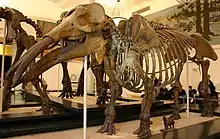gomphothere
English

Gomphotherium productum
Etymology
From Ancient Greek γόμφος (gómphos, “nail, peg, fastener, joint”) + θηρίον (thēríon, “beast”).
Noun
gomphothere (plural gomphotheres)
- Any of the extinct proboscideans of the family Gomphotheriidae, that lived in North America and Eurasia during the Miocene and Pliocene (12—1.6 million years ago), and latterly also in South America (around 3 million to 9100 years ago).
- 1980, Björn Kurtén, Elaine Anderson, Pleistocene Mammals of North America, page 346:
- The main lineage, the bunodont gomphotheres (called bunomastodonts by some authors), can be traced from Phiomia (from the Oligocene of North Africa) to Gomphotherium (a widespread Miocene genus), Tetralophodon (from the Old World and North America), and Stegomastodon (from the late Tertiary and early Pleistocene of North and South America). […] Compared to the simple molars of the mastodonts, gomphothere molars are complex, with additional rounded cusps and accessory conules that wear to a complicated trefoil pattern.
- 2006, Thure Cerling, John M. Harris, Meave G. Leakey, “12: Environmentally Driven Dietary Adaptations in African Animals”, in James R. Ehleringer, Thure Cerling, M. Denise Dearing, editors, A History of Atmospheric CO2 and Its Effects on Plants, Animals, and Ecosystems, page 263:
- In contrast, the early gomphotheres have lowcrowned bunodont cheek teeth that are adapted for crushing and grinding rather than cutting. […] The elephantids emerged from gomphothere stock near the end of the Miocene.
This article is issued from Wiktionary. The text is licensed under Creative Commons - Attribution - Sharealike. Additional terms may apply for the media files.